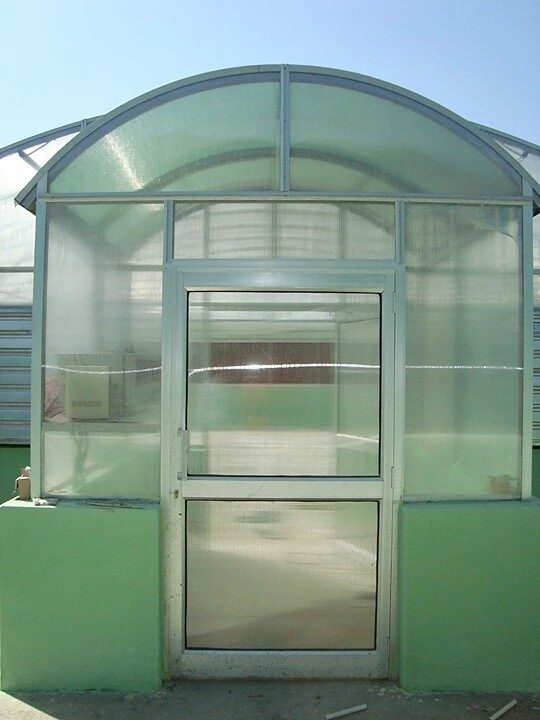Green House

Specifications
1. Dimensions
- Size: Varies widely; common sizes range from small hobby greenhouses (6×8 feet) to large commercial greenhouses (over 100×200 feet).
- Height: Typically 8-12 feet at the peak for small to medium structures; larger commercial greenhouses may be taller.
2. Frame
- Material:
- Aluminum: Lightweight and corrosion-resistant.
- Steel: Strong and durable, often galvanized to prevent rust.
- Wood: Less common, usually treated for outdoor use.
- Shape:
- Gable (A-frame): Classic peak-roof design.
- Gothic Arch: Curved roof for better snow shedding.
- Quonset (Hoop House): Semi-circular shape, often used for simple, temporary structures.
3. Covering
- Material:
- Glass: High light transmission, heavy, and breakable.
- Polycarbonate Panels: Good light diffusion, durable, and lightweight.
- Polyethylene Film: Inexpensive, needs regular replacement (every 3-5 years).
- Thickness:
- Glass: Typically 3-6 mm.
- Polycarbonate: 4-10 mm, often double-walled for insulation.
- Polyethylene: 6-12 mil (thickness unit for film).
4. Ventilation
- Passive Ventilation: Roof vents, side vents, louvered windows.
- Active Ventilation: Exhaust fans, intake shutters, and circulation fans.
- Automated Systems: Temperature-sensitive vents and fan controllers.
5. Temperature Control
- Heating:
- Electric heaters, propane/natural gas heaters, or radiant heating systems.
- Ground heating with heating mats or cables for seed starting.
- Cooling:
- Shade cloths to reduce solar gain.
- Evaporative coolers or misting systems.
- Fans and vents for air circulation.
6. Humidity Control
- Misting Systems: To increase humidity for plants requiring high moisture.
- Dehumidifiers: To reduce excess humidity and prevent mold/mildew.
7. Lighting
- Natural Light: Maximized through transparent covering materials.
- Supplemental Lighting: LED grow lights, high-intensity discharge (HID) lights, or fluorescent lights for extending daylight hours or indoor growing.
8. Watering Systems
- Manual Watering: Hoses and watering cans.
- Automated Irrigation: Drip irrigation, overhead sprinklers, or ebb and flow systems.
- Water Conservation: Rainwater harvesting systems, water recirculation systems.
9. Additional Features
- Benching and Shelving: For plant organization and efficient use of space.
- Flooring: Gravel, concrete, or porous materials to improve drainage.
- Sensors and Automation: Environmental sensors (temperature, humidity, light) and automated controls for maintaining optimal conditions.
10. Maintenance and Durability
- Maintenance: Regular cleaning of coverings, lubrication of moving parts, and checking for damage.
- Durability: Quality of materials and construction affects lifespan; regular upkeep ensures longevity.
Features
1. Structural Features
- Frame: Typically made of aluminum, steel, or wood.
- Covering: Glass, polyethylene, polycarbonate, or acrylic.
- Ventilation: Roof vents, side vents, and exhaust fans.
2. Environmental Control Features
- Temperature Control: Utilizes solar radiation; additional heaters for colder climates.
- Humidity Control: Misting systems, humidifiers, or dehumidifiers.
- Lighting: Supplemental lighting systems for consistent light levels.
- Watering: Automated irrigation systems like drip or misting systems.
3. Design Types
- Cold Frame: Simple, unheated for frost protection.
- Hotbed: Uses compost or heaters for additional warmth.
- Hoop House: Tunnel-shaped, plastic-covered for season extension.
- Commercial Greenhouse: Large-scale, high-tech facilities.
4. Functional Benefits
- Extended Growing Season: Grow plants beyond the normal outdoor season.
- Protection: Shields plants from pests, diseases, and weather extremes.
- Higher Yields: Optimized conditions lead to better and more consistent yields.
- Plant Variety: Grow a wider variety of plants, including non-native species.
5. Operational Challenges
- Cost: High initial setup and ongoing maintenance expenses.
- Energy Use: Potentially high energy consumption for heating and cooling.
- Pest and Disease Management: Requires diligent management to prevent and control outbreaks.
